I’ve had several recent inquiries about my swimming pond, so I figure that it’s about time for an update. This is my favored spot in the garden, where I spend my most relaxed time, and (on rare occasions when I’m sociable) where my wife and I entertain friends and family.
There are six ponds in the one acre garden, one a dirt bottomed wet weather pond, four small ponds with streams and waterfalls, and the swimming pond, though this is a bit of a misnomer since I’m too lazy to swim. Instead, slip into the back garden on any summer weekend day and you’re likely to find me floating on my inflatable lounger, hungry koi circling like sharks.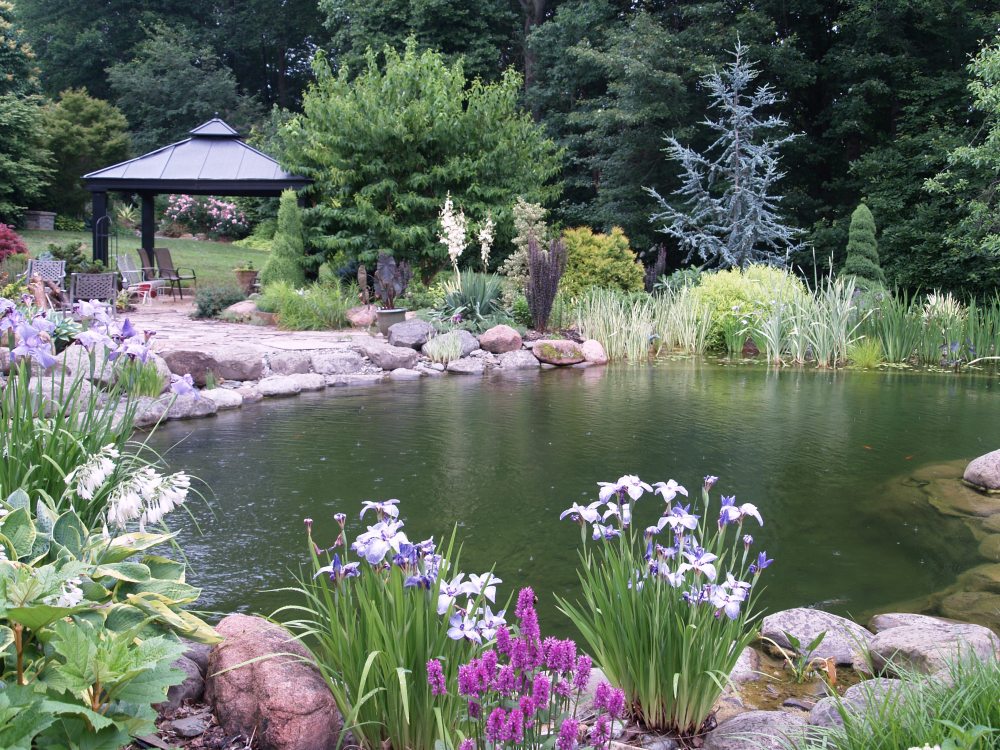
The swimming pond was constructed in 2006, is nearly forty-five feet from the waterfall to a shallow filtration area, and thirty-five feet wide. The depth varies, but is four and a half feet at the deepest point. The pond is lined with EPDM rubber, and a boulder and river gravel covered shelf along the edges just below the water line hides the thick black rubber. The bottom of the pond is covered in small tumbled stones with no sharp edges that could pierce the liner.
Filtration
There are two sections to the pond, the main area of deeper water, and separated by a stone wall a few inches below the water is a two hundred square foot area filled with small bluestone gravel. A submersible eight thousand gallon per hour pump housed in a box with a skimmer door at the pond’s edge delivers two-thirds of its flow to the waterfall, and a third to flexible PVC pipe that is perforated at twelve inch intervals and buried beneath three feet of gravel so that water flows up, and is filtered by the gravel.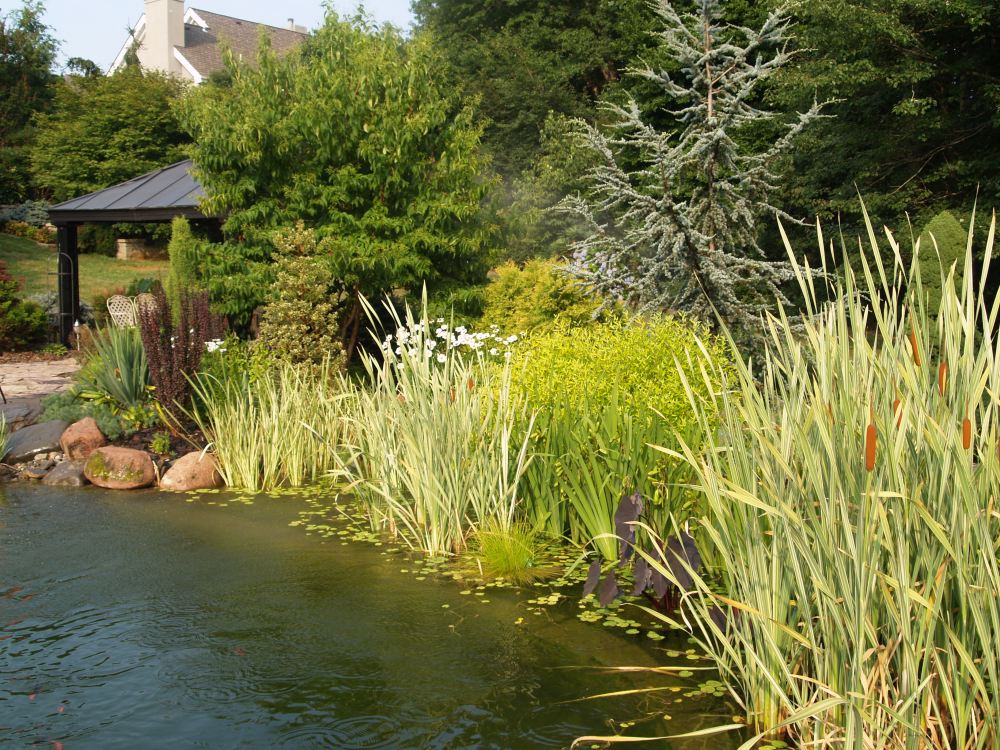
When I was preparing to build the pond I researched the limited resources available, and discovered that most swimming ponds have almost fifty percent of their water surface devoted to filtration. In my limited space a filtration area that large would leave too little area for deep water, so I modified the filtration design to less than fifteen percent of the pond’s surface area.
I don’t test the water, and I’m not certain that I’d like to know what’s there, but the water is clear enough any day of the year to see the gravel on the bottom, which is much cleaner than the ponds I swam in when I was a kid. In early spring there will often be a bit of string algae, but the addition of a barley concentrate stops it from growing, and after it’s removed once by hand I don’t have enough regrowth to worry about.
The skimmer box protects the pump from clogging with a foam filter pad and a leaf net. These are cleaned a couple times a year by dumping the little bit of debris that accumulates in the net, and by hosing off the filter pad.
Since the pond is surrounded by towering trees I cover it with a large nylon net by the middle of October each year. The net is supported by cables to keep it from sagging too far into the pond. By mid-March the net is removed and the soggy leaves dumped in the compost pile. I remove the cables and cut back the spent foliage of the iris and cattails, but that’s it for spring cleanup.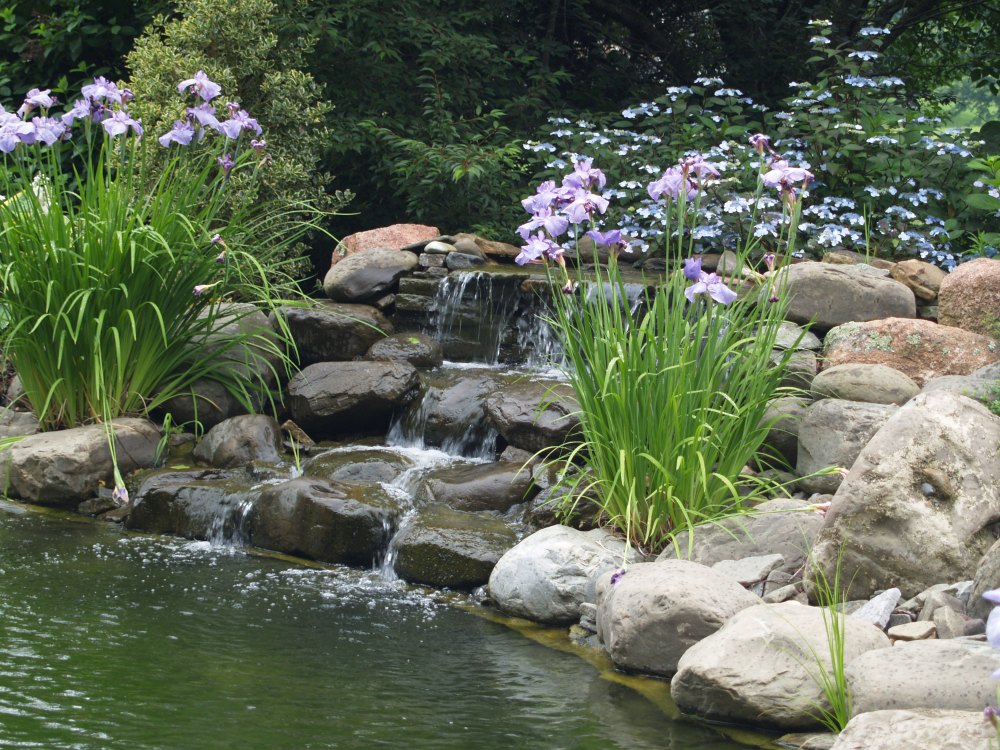
The spring cleanup takes about an hour and a half, and that’s about the only labor spent on maintenance for the year besides a few minutes here and there. There are no chemicals used in the pond besides the barley concentrate, and the water in the swimming pond has never been emptied and refilled, though a few times a year when rain doesn’t keep up with evaporation I add some water.
When purchasing the components to build the pond I bought a large UV light, which was intended to assure the quality of the water, but at the last moment I discovered that I’d have to do more electrical work to install it, so the entire apparatus sits on a shelf in the garage. Also, I had intended to use an external pump rather than a submersible, but changed my mind, and have used the same pump without a problem. I’ve had pumps in the small ponds that have lasted ten years and longer, and I don’t see any reason why this one won’t.
Fish
None of the resources I consulted recommended having fish in a pond that you swim in, and I suppose the reasons are obvious, but I wanted to swim with the fish, so that seemed to be reason enough to ignore the recommendations. I was happy with my decision from the start, and am overjoyed after four years to have fish, and have never had a reason to think otherwise. I began with a dozen small koi, but as nature takes its course, a dozen became thirty, and then fifty or seventy. Some day there will be too many, and then I’ll have to transfer some to the other ponds, but for now, whatever number there are, it’s perfect.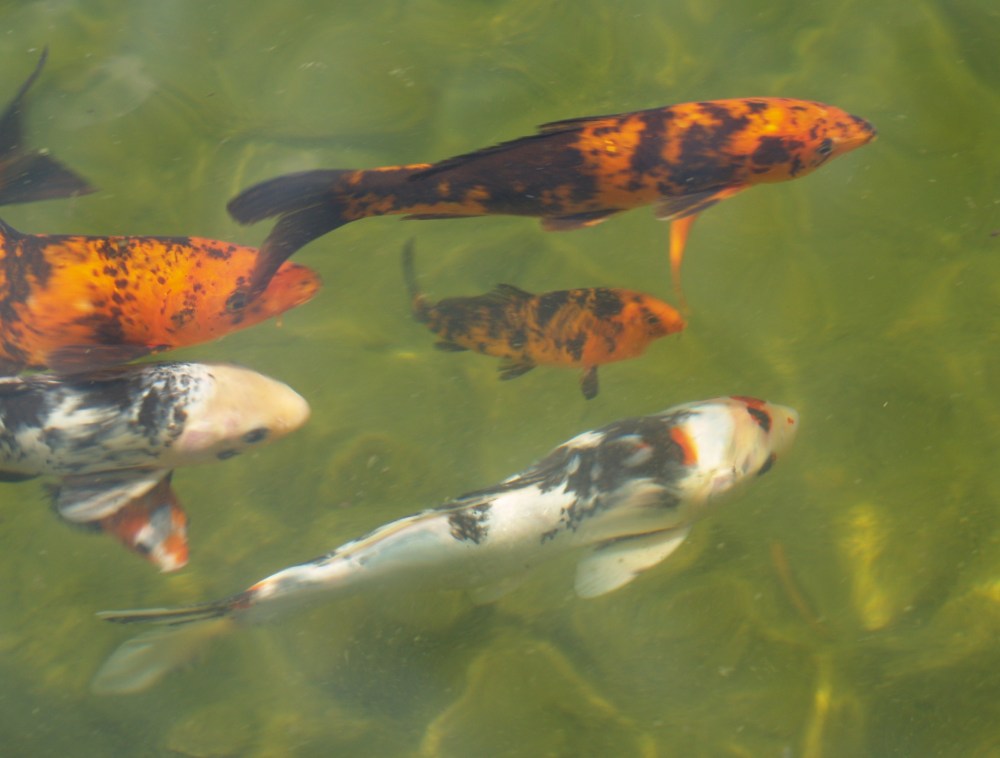
Sometimes I feed them, sometimes not, but they require no care at all, and they’re always excited to see me.
Wildlife
With ponds you have frogs (there is no choice in the matter), and with six ponds there are lots of them. The racket from spring peepers is loud enough some evenings that I must close the windows to sleep. Walk down any path in the garden and you’ll hear the splashing of frogs into the stream and ponds, though if you move gently you might approach within inches before they flee.
There’s an occasional garter snake, but they’re so shy that they’re no concern, even to my wife. In the more shallow ponds I’ve had problems in years past with garters poaching small fish, but that has not been a problem in the larger pond. Nor are herons a problem in the swimming pond, where they are not able to stand in the deeper water.
There are plenty of dragonflies that dart about and perch on the cattails, surveying their domain to snatch the stray mosquito. And there are a variety of water skimming bugs zig zagging across the surface, and I’m surprised that the koi pay them no attention, perhaps they have too little substance to be considered a meal.
I have seen groundhogs, chipmunks, and squirrels stop for a drink, and know that deer and fox, skunks and possum visit the garden. Birds stop to splash about in the shallow water above the waterfall, and will hop from rock to rock in the shallow filtration area (under the cover of the tall iris and cattails) for a drink.
There has been only one occasion where geese were found in the pond, and a few ducks once, but they must be more comfortable in the larger, nearby farm ponds, where they are numerous.
Plants
In the filtration area of the swimming pond I have planted variegated cattails, tall striped sweetflag, Japanese and yellow flag iris, and floating hearts directly into the small bluestone gravel. When the water and air temperatures warm in late spring I plant tropical cannas, elephant ears, and dwarf papyrus that grow huge in the shallow water.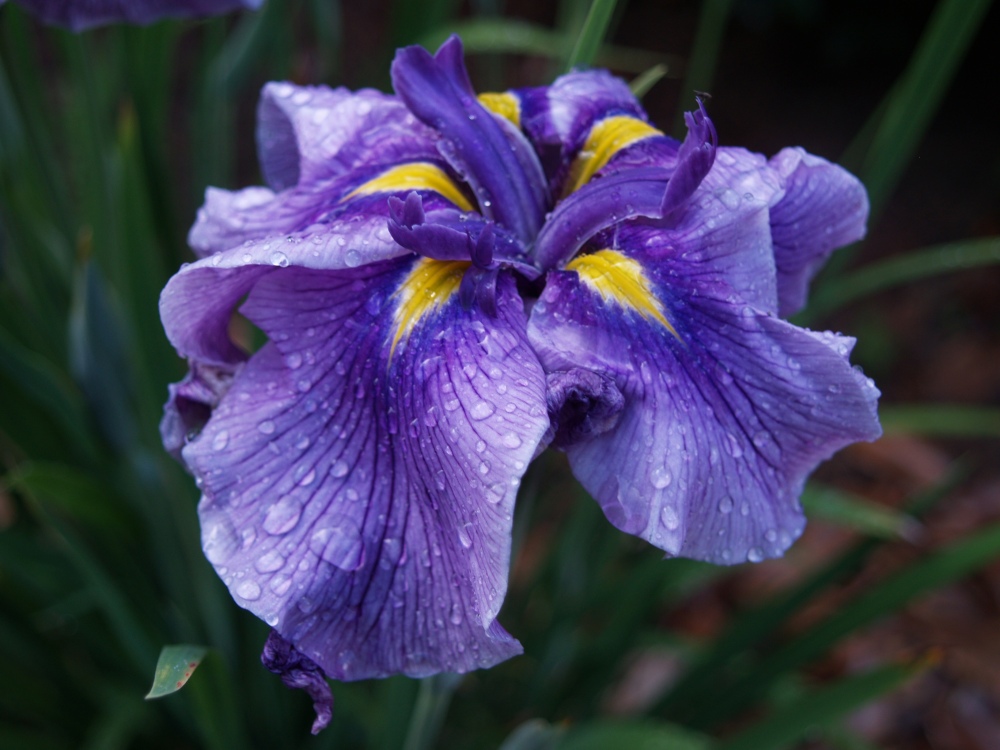
The aquatic plants help to filter nutrients from the water, but my purpose is to naturalize the pond’s edge, so between boulders half submerged at the water’s edge I’ve planted colorful Japanese iris, rushes, and calla lilies. In the soil above the boulders that edge the pond large leafed hostas and hydrangeas, and winter jasmine tumble to blend the pond with the garden.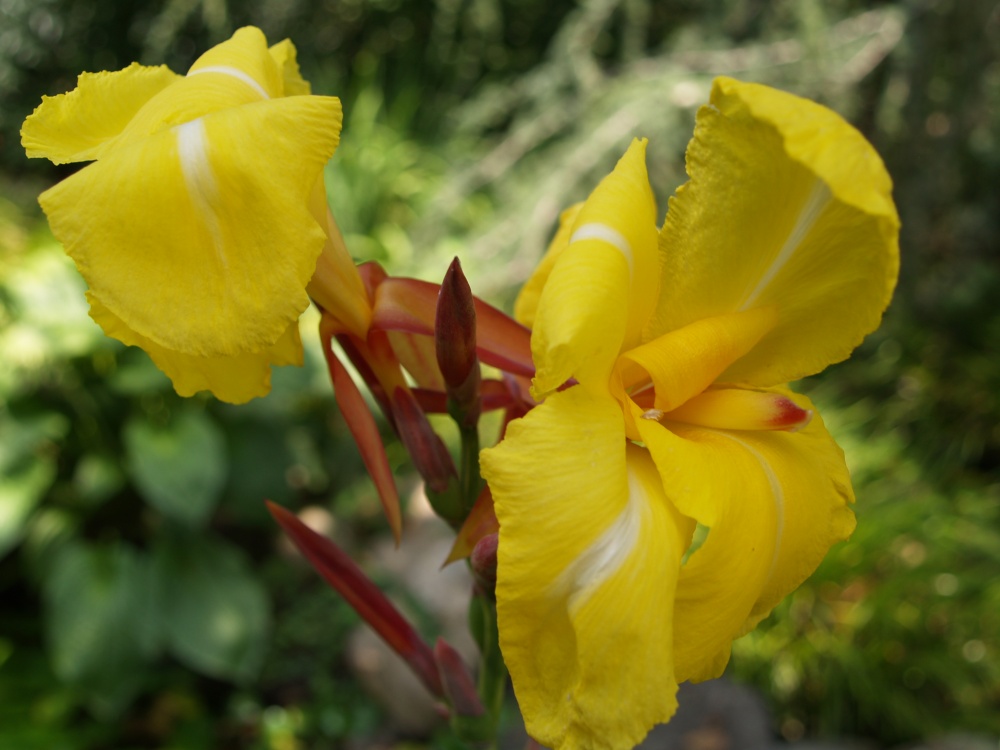
The deep part of the pond is not planted, and floating hearts that wander from the filtration area are tugged out and tossed onto the compost pile.
Considerations
First, you should be aware that most communities consider any pond deeper than two feet to be a swimming pool, and permits and fences are normally required for safety.
Most pond building guides recommend against constructing near trees, where leaves will blow into the pond. I have no choice, my property is surrounded by trees, so I cover the ponds with netting in October that is removed in March. If the pond was fouled with leaves I’d be forced to empty the water to clean the mess in the spring, and I don’t intend to ever have to pump out the pond’s twenty-five thousand gallons and refill it.
The swimming pond in my garden is halfway to the back property line, so that you must follow paths past three smaller ponds, and cross a small lawn area to reach it. The pond (and the plantings that surround it) brings the upper and lower portions of the rear garden together, so that it is perfectly located, but in most situations the pond will be appreciated more if it is closer to the house.
When I first built the swimming pond I included a stone patio and firepit, and the following year added a metal summerhouse and another small patio. The planting area around the pond has been added to continually, and I’m certain that part of the project will never end.
Dear Dave,
I enjoyed reading uour article about your swimming pond. Would you help me build one, and if yes, how much would you charge? I am not saying that I am sure yet I want one-just getting an estimate.
How big an area would be needed-I do have a large flat back-yard but I do not know what a large suburban backyard amounts to in comprison with farm yards. I could measure it to give exact measurements if I get serious. It would be so great to have a swimming pond 3with a garden railway going around it.
Molly
Theswimming pond in my garden is 40′ x 35′, but I think that a pond of at least 500 square feet would be a minimum to consider for this purpose. This would require an area of at least 25′ x 25′. Meadows Farms builds ponds from little puddle sized ponds to as large as you’d like. We do all design and installation, as well as obtaining applicable permits for ponds deeper than 24 inches. A very rough price estimate for a large pond, including boulders, pumps, and installation, is in the range of $25-$35 per square foot, but there are many variables that can make the pond more expensive (such as limited access, extra large boulders). If you are interested please let me know and I will have one of our Landscape Designers contact you.
I would love to get more information on building a swimming pond on my property. Please feel free to contact me…are the quotes/estimates free?
Fabulous!! I’m jealous! I live in a townhouse & have a small pond in the back. I love it, but can’t wait to move to a larger property so I can expand my visions of a paradise like yours!!
Awesome!
I’ve been researching swimming ponds for quite some time & yours is EXCEPTIONAL.
Love all the Meadows Garden Centers…especially Harpers Ferry site&personnel…got a few acres here perfect for such a lovely feature!
Thx for sharing it.
Thank you for your kind comments. In my garden there are five ponds, several patios, and more plants than I can count. The swimming pond is the part I enjoy most.
What a glorious pond. Just beautiful. I will save your pictures for inspiration!
Who doesn’t love the sound of water? Right now all I have is the sound of the turtle tank running in the living room and the birdbaths in the back yard-when there is a bird splashng in one! Loved your stories and your photo’s I too will keep this article for inspiration!
Beautiful garden and ponds! However, most urban homeowners are better off with a simple, self contained fountain or pond since the prohibitive costs and maintainance can be over whelming in a large garden setting. I have two small fountains that provide the sound of tricking water and attract wildlife visitors. Same benefits without the big $$ and constant maintainance of large, in ground ponds.
Dave – great looking pond and great article. Love the boulders and plants etc.
Just curious why you don’t have a fountain. I have a small pond (7X12X2.5) of about 2000 gal. This is after 3 upgrades and 1 downgrade. We have lots (40 ish) of fancy goldfish. Started with 8. D you have and snailos to help with the cleanup on the bottom?
I have always had a fountain and a watefall. Sometimes I wonder if it’s too much action. I prefer to have lots of movement with the water to prevent mosqutoes. I live in a planned community w/ only about 1/4 acre. I don’t want to be accused of adding to a mosquito problem. Also through the summer seems like I’m always topping off the water level by 2-3 inches, surprised that you don’t need to do the same. I would like to send a couple pictures and get your reccomendations for any changes or modifications that you would make.
I have tried to construct my ponds to be as natural as possible, and a fountain detracts from that look. All the garden’s ponds have rock below the water line and river gravel on the bottom rather than bare rubber. This turns the entire pond into an ecosystem that encourages beneficial bacteria that break down organic materials in the pond (fish waste, leaves, and other plant debris).The ponds have thriving communities of frogs, dragonflies, all sorts of floating and skimming bugs, and occasionally small snakes, but no snails (unless they’ve wandered in on their own.
There are no mosquitoes. Although the water surface of the ponds is still, the fish and other critters do this work.
Evaporation is inevitable, so there are times when I have to add water. When the water level of a 1500 square foot pond drops it can take a few hours to refill it, but I need to add a few inches only a few times each year since rain usually does the refilling. I’m happy to take a look at photos of your pond. I’ve had ponds in the garden for over twenty years, and the first pond has been reconfigured four or five times. I’ve made plenty of mistakes, and along with researching problems I’ve learned at least a thing or two.
I just love the idea of having ponds, but have worried that our 3 large dogs and 1 small, all of whom love the water, would puncture a lining. Any ideas? Thank you!!!
The liner on all of my ponds is covered with rock or gravel so that there is no exposed rubber. There’s very little chance that a dogs claws will go through the couple inches of gravel to damage the liner, so I wouldn’t let hold you back.
Your gardens sound idyllic! Do you ever set up garden tours for your customers? I’d love to come visit your ponds and be lured past the expense barrier… 😉
Perhaps someday, but I’d be forced to clean up the trash and brush piles, so for now photos will have to do.
Your pond article is very interesting. I had never heard of a swimming pond although back in my youth we had natural ponds on the farms nearby. We have a pond in our yard, 11′ x 17′ but obviously not of your caliber. I got some good ideas from your article and appreciate it.
Fortunately or not, the idea for the swimming pond went from a momentary thought, and nah, it’ll never happen, to a sketch, to research, to a material list all in an hour or two. Occasionally I’ll be intensely motivated by a project, and stand aside or you’ll be run over. That’s how this worked. I don’t think I ran the idea past my wife until I had downloaded an e-book on swimming ponds and ordered several thousand dollars in materials. Luckily, my haste did not hinder the project, and if I had it to do over there’s not a single thing I’d do differently.
I don’t float in the pond as much as I used to, but I spend as much or more time in the garden centered around the pond as ever. I built the pond for me. The neighbors can’t see or hear it, and most don’t know it exists. I can’t imagine the garden without the swimming pond.
Hi Dave,
I’m just west of you in Purcellville, and looking for build info on a swimming pond. Can you tell me the name of the book you ordered and if it was helpful?
Thanks!
Here is the link to the book that I ordered http://www.amazon.co.uk/exec/obidos/ASIN/0764321838/interactiveda3401-21 There was also an e-book, but I don’t recall where it came from. I scanned the books for information, looked at some photos and diagrams, and with my previous pond building experience I was ready to go after a few hours of research. I didn’t follow the recommendations in the books too closely since this would have meant the filtration area would be disproportionately large, but the end result has worked out exceptionally well.
Hi Dave! I laughed out load when I read how your sequence of events occurred because I have a very similar story. My husband and I had large above ground pool that I was tired of maintaining. Kids are all moved away not much incentive to spend hours a week cleaning something that maybe would be used twice a summer. Also, blonde hair and chlorine is a crap-shoot. So I knew the old pool was going, one way or another. Long story short…(I know”too late”)…one rainy day last summer I drew up plans for a natural swimming pond that would take up a large part of the main backyard. Before my husband knew what hit him I had the liner ordered and pulled down the old pool. Found and purchased an eBook. I even started digging the area by hand until he took pity on me and brought home the backhoe from work. Nearly one year later we are almost finished with it and ready to fill it with water. The dimensions are roughly
40 x 20 with a rectangular swimming zone made from cedar logs and waterfall on one long side and regeneration zone surrounding three sides. You may wonder how will we hold down those logs…lots of boulders and gravel. Anyway, I wanted to also tell you your pond/yard is absolutely beautiful!!!
Amazing article & pond! We are digging a 17x 35 this weekend.One of my major questions is the pump .The info out there is overwhelming.Submersible/external ? GPH ? etc.The liner company also recommended we not put rocks on the liner but is something we want.Also wonder about the shock hazard if we are in it? Regardless-thank you for sharing some insight into your natural area.
I purchased an external pump for my swimming pond, but when I was to the point of installation I opted to switch back to a submersible. No rhyme or reason, just that I’m more familiar with installation of submersibles from the other ponds in the garden. The pump operates off of a GFI outlet, so I have no qualms about being submerged in water where an electrical motor is operating.
I forget the calculations that went into the decision to use an 8000 gph pump in my pond, and I don’t recall if I followed the guidelines on swimming pond references I checked. I constructed the pond with rock on the bottom, which wasn’t recommended by any of the resources, so I had to wing it a bit in making some decisions where I thought one thing balanced another. My pond has small tumbled rocks on the bottom, and I gave very little consideration to the possibility of punctures. I knew that I would be floating rather than standing on the pond’s bottom more than occasionally, so it was less of a concern.
If I had planned on walking in the pond I would have placed a layer of fabric pond underlayment over the liner in addition to the layer that’s under the liner. EPDM liner is quite tough, and though it’s natural for the liner company to recommend against rock, as long as the rock is not sharp edged there is little chance of puncture. All of my ponds have tumbled rock or river gravel over top of the liner so that no liner is visible above or below the water. I’ve never had a puncture. I’ve known people who have jabbed various implements through their liner, but it doesn’t happen often.
Dave-trying not to get discouraged here.The pond has been filled for bout 2 weeks’plants in the bog for a week.The water just keeps getting greener?Is this normal or do we have a major imbalance? Got one pump feeding the bog under gravel & one to a waterfall.The plants almost seemed to make it worse.Is this similiar to your experiance?
Starting a pond in the heat of summer is more challenging than in October when my pond was first filled. Algae requires nutrients and sunlight to grow, and until a colony of bacteria is established algae can be a problem. I can’t explain in detail, but bacteria consume and convert nutrients to a form not usable by algae. The bacteria will form naturally, or you can speed it along by adding seed bacteria that is commonly available through pond suppliers.
Thank you so much for your post. I had questions about which plants to use and your post answered them for me. I am so delighted to read I can use elephant ears and cala lilies.
Hi, Dave! I was so excited to find this posting. My husband and I are contemplating building a swim pond, but haven’t been able to find much information on it, and we want to do it the right way and benefit from other people’s experience. Imagine my surprise when I figured out you were with Meadows?!? We live in Massaponax, VA, right in your neck of the woods. We LOVE Meadows– there is one at the end of our road that we frequent all the time.
One question I have is this– is it possible to work with a Landscape designer, then do some/all of the work ourselves and if so, what does that cost? My husband and his father have experience building and excavating, and both actually worked for the family electrical company. (My father-in-law has since sold off his share of the company and retired).
Our landscape designers are available for consultation and design for a $50 fee. For a specialty feature like a swimming pond they won’t be able to offer much expertise on how to build it, but they could help in deciding where best to locate it. You can contact a designer through Meadows Farms website.
Is it possible to convert an in ground pool into a swimming pond? We have an irregularly shaped pool that currently holds 29,000 gallons. It is 10 feet deep to 3 feet deep & we could gladly fill it with lots of gravel.
Yes, a swimming pool can be converted to a shallower pond without all the filtration equipment. When the pond is partially filled in the concrete (or other) liner should be cracked to allow drainage. Otherwise, the pool will hold water and when it fills, everything above will become waterlogged or float. Once the concrete is broken, the pool is filled with gravel or soil (or some of both), and the pond is built to the desired depth with a flexible rubber liner. In some cases the pool coping is also demolished and removed so that it is not seen.
Dave, First of all Thank you. So far the best resource i’ve come across. I have a fairly large spring fed pond about 100 feet by 50ft, on my 5 acre property in Northern California. I’ve already decided to convert it to a regenerative swiming pond. I have had 140 tons of granite boulders delivered which are waiting to be used as a rock wall perimieter. I will soon drain it as much as possible and begin the work but still need a complete game plan. I’m planning two filtration zones on each side, about 1/3 of the total size. The depth of the swimming area will be about 7 feet at its deepest point. I was going to do a gradual slope from the swimming area up to the baffled top of the filter zone. My thought is to use a liner for the sides, but not the bottom. I instead was going to line the bottom with small to medium sized rock about 6 inches thick and this rock would hold the side liner in place at the bottom. The reasons I am not thinking of using a liner is because the pond is spring fed and does not lose water. This will save me a great deal of money and doesnt seem necessary if my pond holds water. It seems to make sense to keep the bottom natural and use a liner only for the sides to help prevent erosion. I am planning a sand beach feature that steps down into the swimming area on one side and river bed feature on the other. Pumps will draw water from the filtration sides and pump half to the top of the granite river bed which will run back into the swimming area and the other half back into the bottom of the swimming area (I read somewhere that the bottom is the best place for the outlet to help keep the bottom clean…your thoughts?). I too have trees that i don’t want to part with and had thought of doing what you do with a large net in the fall/winter. My questions are what are your thoughts on not lining the bottom? Also, can you explain how you designed your filters? I was thinking of building a long narrow box that’s buried under the gravel that contains the pumping mechanism. I will also need a skimmer and havent done much reseach on that yet. Any other thoughts or advise on my plan as I have described it?
As long as the earthen bottom holds water this should work well. The liner on the sides must be fully anchored or it will balloon upward, but the liner should stabilize the sides against erosion as you’ve planned. I considered a bottom drain when I first planned my pond, but the finishing up of digging and laying the liner was hurried along because of impending storms, so I abandoned the idea and went to a submersible pump like I have on the other ponds. In my pond the water is drawn to the pump directly, rather than through filtration, other than a leaf net to prevent the largest debris from chocking the pump. My pump is 8000 gph and I was a bit concerned that if the gravel filter became clogged the water flow might not be adequate.
I have split the outflow from my pump so that two thirds goes to the waterfall (for aesthetics and to a lesser degree for aeration) and the other third goes to perforated pipe buried beneath three feet of gravel so that water flows up through the gravel into the pond. In my experience with smaller ponds the gravel filter and gravel on the bottom of the pond help cultivate bacteria that keep nutrient levels to the point where algae doesn’t grow rampantly, even with a large number of fish.
Thank you so much. I was planning on anchoring the liner on the bottom simply with about 2 feet of gravel. o you think would be sufficient? If you have an outlet under 3 feet of gravel, I assume that means your gravel bottom is 3 feet deep? That seems really thick. I would assume the best way to do this is to have a final taper that is only a fraction of the total size of the pond like this link I found? http://kilk.com/pond/ . I was inspired by his use of sand bags and simplicity. Does your outlet of water under the gravel displace the gravel and present any problems? I was going to run it on top, but your ideas sounds great if it’s working for you. I think I’ll do the same and run 1/3 to a waterfall, 1/3 down a 30 ft rock bed and 1/3 out the bottom. I think my biggest obstacle will be cleaning and shaping the pond, since geting it and keeping it dry will be hard and require constant pumping while working. How large is your pond? Thanks again. If you can shed some light on my questions I would greatly appreciate it.
The gravel filled filtration area is only about fifteen percent of the pond’s square footage, far less than what most references recommended. It has about three feet of gravel with perforated pipe underneath and a foot of water on top. I’ve planted yellow flag iris, variegated cattails and acorus, pickerel weed, and a few water lilies in the gravel to pull out nutrients and to mask the gravel. I forget how many years I’ve had this pond but there ‘s never been a problem with the gravel (at least that I’ve noticed), and with netting the pond in winter to keep leaves out I’ve never cleaned it other than to wade into the shallow gravel area to cut plants back in early spring.
The pond is forty feet in length by about thirty five feet wide, but with an irregular shape so there’s less sqaure footage. The main section of the pond tapers from three feet at the edges to five and a half feet deep, and on the bottom there is only a few inches of gravel. If the gravel is deeper it can become anaerobic, but with water flowing up through (or being pulled down through) this isn’t a problem.
I’m still a little confused on the discharges from your pump. You said that 1/3 goes up through perferated pipe under 3 feet of gravel. I assume this is in the bottom of the “swimming” portion of the pond and not the filtration portion? Is this correct. If so you have 3 feet of gravel in the entire bottom of the pond, or just one section where the discharge is? My pond is about 100 feet wide by about 50 feet. I’m dedicating about 40% to filtration when all is said and done., so it’s good to hear that 15% is working great for you.
I have walled an area of the pond off for the filtration area, so only this small area has deep gravel. The largest portion of the pond has only a couple inches covering of gravel. The entire pond is perhaps 1500 square feet, including the area of about 225 square feet on one end that is the filtration area.